For PC gamers, there isn’t a more important component than a graphics card, but it can be tough to find the best graphics card for you. GPU reviews don’t always tell the full story, and tracking down the graphics card that offers the best value between cost and performance isn’t as simple as shopping online.
We dug through our graphics card reviews to bring you a definitive ranking of the best GPUs for gaming. The competitiveness between AMD and Nvidia is hotter than it has been in years, and we have several options from both brands. If you’re new to building PCs, make sure to read our answers to common GPU questions. We also have a full guide on how to install a graphics card so you can upgrade your PC.
ZOTAC GAMING GeForce RTX 4070 Ti AMP AIRO Spider-Man Edition
The best custom GeForce RTX 40 Series
Jump to details

ZOTAC GAMING GeForce RTX 4070 Twin Edge
The best for RGB lovers
Jump to details


Nvidia GeForce RTX 4070
The best graphics card for 1440p gaming
Jump to details

Nvidia GeForce RTX 4080
The best graphics card for 4K gaming
Jump to details

Nvidia GeForce RTX 3060 Ti
The best graphics card under $500
Jump to details


Nvidia GeForce RTX 4090
The best graphics card for video editing
Jump to details



Nvidia GeForce RTX 3060 mobile
The best graphics card for laptops
Jump to details

Nvidia GeForce RTX 4070 Ti
The best graphics card with DLSS 3
Jump to details
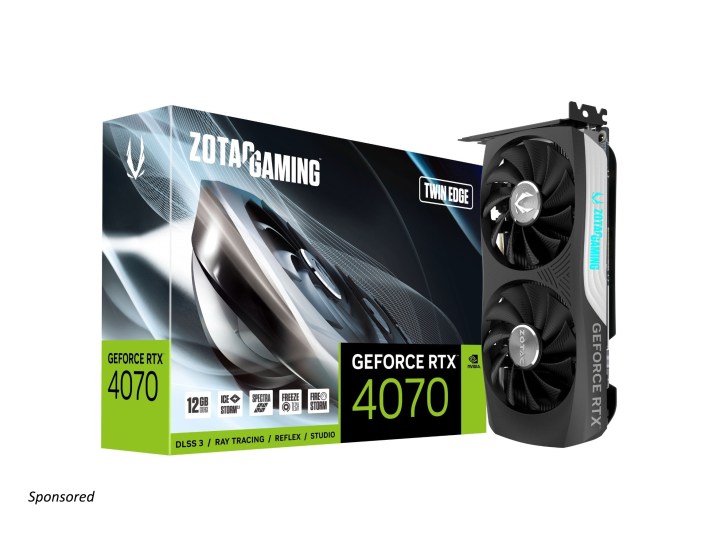
ZOTAC GAMING GeForce RTX 4070 Twin Edge
The best for RGB lovers
Pros
- SPECTRA RGB lighting
- 12GB of GDDR6X VRAM
- IceStorm 2.0 advanced cooling
- Ideal for 1080P or 1440P gaming
- Supports up to four displays
Cons
- Alan Wake 2 deal not exclusive
**Why should you buy this: **It’s ideal for 1080P or 1440P gaming resolutions, supports up to four monitors, has NVIDIA’s DLSS 3 AI-driven technology, and has excellent RGB lighting.
**Who’s it for: **Anyone ready to upgrade to a GeForce RTX 40 Series card.
What we thought of the ZOTAC GAMING GeForce RTX 4070 Twin Edge:
The ZOTAC GAMING GeForce RTX 4070 Twin Edge is ready to rock and is an excellent choice for 1440P or 1080P gaming, a VR setup, or, when you’re ready, an 8K system too. With 12GB of GDDR6X dedicated VRAM, you can run virtually all newer games on high settings or above.
Moreover, it offers NVIDIADLSS 3 AI-driven technology, supporting the ultra-efficient Ada Lovelace architecture with full ray tracing for incredible lighting and visuals. IceStorm 2.0 advanced cooling helps ensure the card remains cool to the touch, even at heavy loads. Two 90mm fans, with a FREEZE fan stop control and active fan controls, enhance your customization options.
All that power counts for something, too, as this card is 8K-ready once you’re ready to upgrade your monitor. Until then, 1080P, 1440P, and in some cases 4K gaming resolutions will work just fine, and it features three DisplayPort 1.4a and one HDMI 2.1a. The Black Friday deal live now from Newegg drops the price to $515 and offers a freebie. With select GeForce RTX 40 Series cards, you get a digital copy of Alan Wake 2 for PC. A discount and a free game? Sign me up.

ZOTAC GAMING GeForce RTX 4070 Twin Edge
The best for RGB lovers
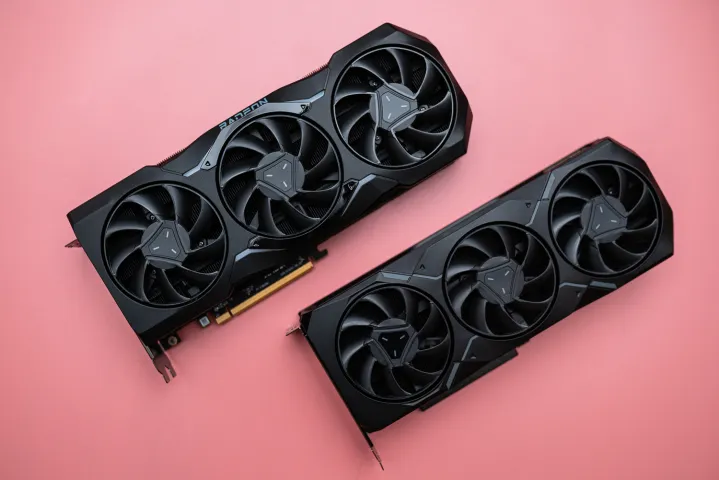
AMD Radeon RX 7900 XTX
The best graphics card for gaming
Pros
- Fantastic value for the RX 7900 XTX
- Playable ray tracing performance
- High refresh rate 4K gaming
- Standard 8-pin power
Cons
- Disappointing generational improvements
- Loud and hot
Why should you buy this: It offers some of the best 4K gaming performance you can find today, and at a reasonable price.
Who’s it for: High-end gamers who need high frame rates, but don’t care much about ray tracing.
What we thought of the AMD Radeon RX 7900 XTX:
The lineup of current-gen GPUs all have one thing in common: they’re expensive. That makes choosing the best GPU tough, but AMD has a compelling offer this time around. The RX 7900 XTX offers flagship performance at an excellent value amid the inflated landscape of GPU prices right now.
For raw performance, the RX 7900 XTX is capable of running the most demanding PC above 60 frames per second (fps), and in the case of titles like Red Dead Redemption 2 and Horizon Zero Dawn, it can even hit around 100 fps. It can go toe-to-toe with Nvidia’s RTX 4080, all while costing anywhere from $200 to $400 less.
In addition, it’s smaller, and it calls for standard 8-pin power rather than the 12-pin connector featured on Nvidia’s most recent GPUs. That doesn’t mean the RX 7900 XTX is without faults. It gets loud and it runs hot and compared to Nvidia, it lacks prowess in ray tracing games.
Even with those caveats, the RX 7900 XTX is an excellent graphics card that can power high-end gaming in demanding titles like Cyberpunk 2077.

AMD Radeon RX 7900 XTX
The best graphics card for gaming
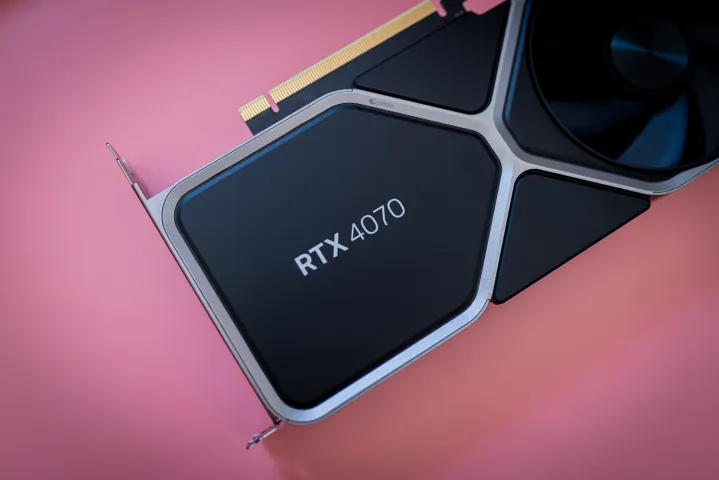
Nvidia GeForce RTX 4070
The best graphics card for 1440p gaming
Pros
- RTX 3080 performance for $100 less
- Only two slots
- DLSS 3
- Remarkable efficiency
- 1440p gaming at 100+ fps
Cons
- Beaten by AMD’s RX 6950 XT
- Far below RTX 4070 Ti
Why should you buy this: It’s Nvidia’s first affordable RTX 40-series graphics card, and it supports DLSS 3.
Who’s it for: Midrange to high-end gamers looking for a GPU that can handle the most demanding games at 1440p.
What we thought of the Nvidia GeForce RTX 4070:
The RTX 4070 is a turning point in Nvidia’s latest generation of graphics cards. It’s the first model that delivers a better value than the previous generation at a realistic price, hitting a sweet spot for 1440p that’s perfect for midrange to high-end gamers.
In our testing, it matches the RTX 3080 from the previous generation at 1440p and 4K while costing around $100 less. It’s also much smaller than Nvidia’s other Ada Lovelace GPUs, making for a much more practical upgrade for gamers who don’t have a massive power supply and case.
Perhaps most importantly, the card also supports DLSS 3. That means DLSS Frame Generation is an option if you want to play demanding games like Cyberpunk 2077‘s Overdrive mode or Portal RTX. The card isn’t as powerful as Nvidia’s recent flagships, but DLSS 3 helps close that gap in the most demanding games.

Nvidia GeForce RTX 4070
The best graphics card for 1440p gaming

ZOTAC GAMING GeForce RTX 4070 Ti AMP AIRO Spider-Man Edition
The best custom GeForce RTX 40 Series
Pros
- Excellent Black Friday price
- 12GB of GDDR6X VRAM
- IceStorm 2.0 advanced cooling
- Good for 4K Gaming and is 8K-ready
- Supports up to four displays
Cons
- Spider-Man theme for aesthetics only
Why should you buy this: It’s no web shooter, but it is an excellent and powerful GPU
**Who’s it for: **Anyone who wants a capable GeForce RTX 40 Series GPU at a fantastic price
**
What we thought of the ZOTAC GAMING GeForce RTX 4070 Ti AMP AIRO Spider-Man: Across the Spider-Verse: **
The name might be ridiculous, but the theme is great. Yet, every self-respecting gamer knows that no matter what’s aesthetically added to your GPU, you’ll see no performance boost, no matter how badass it is. That’s why the hardware matters most, and the ZOTAC GAMING GeForce RTX 4070 Ti AMP AIRO is no slouch in that department either. You get 12GB of GDDR6X dedicated VRAM, plenty of power to run all the latest titles on high or above at 4K resolutions. The Spider-Man: Across the Spider-Verse theming can also be removed.
Moreover, it offers Nvidia DLSS 3 AI-driven technology, supporting the ultra-efficient Ada Lovelace architecture with full ray tracing for incredible lighting and visuals. IceStorm 2.0 advanced cooling helps ensure the card remains cool to the touch even at heavy loads. That’s in no small part, thanks to the three 90mm cooling fans.
All that power counts for something, too, as this card is 8K-ready once you’re ready to upgrade your monitor. Until then, 4K will work just fine, and it features three DisplayPort 1.4a and one HDMI 2.1a. The Black Friday deal live now drops the normal $880 price to $792, saving you $88 right off the top. That’s a great deal for a card of this much power, let alone one of the newest GeForce RTX 40 Series options.

ZOTAC GAMING GeForce RTX 4070 Ti AMP AIRO Spider-Man Edition
The best custom GeForce RTX 40 Series

Nvidia GeForce RTX 4080
The best graphics card for 4K gaming
Pros
- Excellent power efficiency
- Fantastic 4K performance
- DLSS 3 support
- Solid ray tracing performance
Cons
- Large and bulky
- Not as good of a value as the RTX 4090
Why should you buy this: The RTX 4080 is expensive, but it feels tailor-made for 4K gaming.
Who’s it for: 4K gamers who need above 60 fps in the most demanding games.
What we thought of the Nvidia RTX 4080:
The RTX 4080 is too expensive for what it is, but it’s still a highly capable 4K GPU. Below the price of the monstrous RTX 4090, the cheaper RTX 4080 still delivers high frame rates at 4K, even in demanding games like Cyberpunk 2077.
Although the RTX 4080 isn’t quite as powerful as the RTX 4090, features like DLSS 3 help fill in the gap. That makes ray tracing possible at 4K, even at high frame rates. DLSS isn’t new, but the addition of frame generation on the RTX 4080 can massively boost your frame rate in demanding titles.
The card is big and bulky, but unlike the RTX 4090, it doesn’t require a ton of power. It stays at the same wattage as the previous generation, and in real-world use, it actually consumes about 50W less.
For video editing, it’s tough to beat the RTX 4080. Although there are better value options for gaming, Nvidia still has a massive lead in video editing, and it accelerated tasks in apps like Adobe After Effects and DaVinci Resolve in a way that AMD graphics cards just can’t.

Nvidia GeForce RTX 4080
The best graphics card for 4K gaming

Nvidia GeForce RTX 3060 Ti
The best graphics card under $500
Pros
- Fantastic cost-to-performance ratio at MSRP
- Great for 1440p gaming
- Close to the RTX 3070, but cheaper
Cons
- Not the best option for 4K
Why should you buy this: The RTX 3060 Ti punches well above its weight class.
Who’s it for: 1440p gamers who want all of the visual bells and whistles.
What we thought of the Nvidia GeForce RTX 3060 Ti:
The RTX 3060 Ti is an extremely powerful graphics card, considering its spot in Nvidia’s Ampere gaming lineup. Below the RTX 3070, the 3060 Ti still delivers 8GB of GDDR6 memory on a 256-bit bus and features only a slight reduction in clock speed — 1.67GHz on the 3060 Ti versus 1.72GHz on the 3070. It’s best suited for 1440p gamers that want high frame rates without the high price.
In benchmarks, the RTX 3060 Ti scores above last gen’s GeForce RTX 2080 Super. The card can deliver above 70 fps in demanding titles like Red Dead Redemption 2 with Ultra settings at 1440p. In games like Control, you can take advantage of features like DLSS to boost your performance, too.
The RTX 3060 Ti shines as the best graphics card for 1440p. It’s incredibly capable, offering frame rates north of 60 fps in demanding AAA titles, even with all the sliders turned up. Ray tracing would normally be a problem for a card like this, but thanks to DLSS, you can still hit performance marks with all the visual bells and whistles.

Nvidia GeForce RTX 3060 Ti
The best graphics card under $500
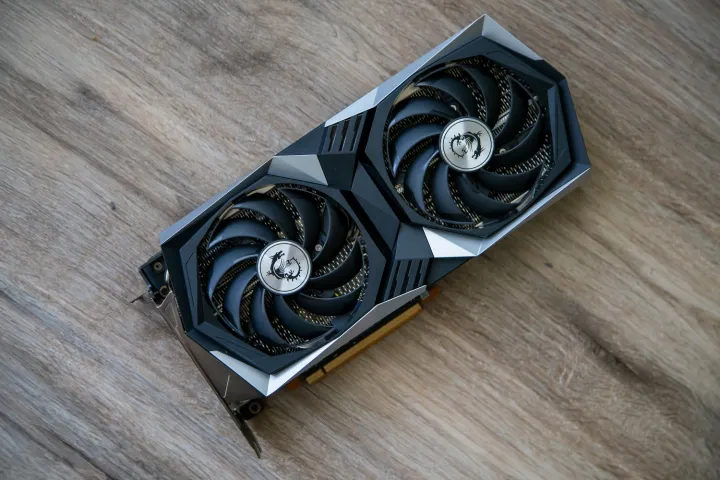
AMD Radeon RX 6600 XT
The best graphics card under $300
Pros
- Smooth gaming at 1080p
- Doesn’t require a lot of power
- Capable of 1440p gaming
- Support for FidelityFX Super Resolution
Cons
- A little too expensive
- Lackluster content creation performance
- Poor ray tracing performance
Why should you buy this: It’s the best 1080p gaming graphics card around, and secondhand models are cheaper than the Nvidia RTX 3060.
Who’s it for: The 1080p gamer with a high refresh rate display.
What we thought of the AMD Radeon RX 6600 XT:
The AMD Radeon RX 6600 XT isn’t great value — but in a time when GPU options are so overpriced, that hardly matters. What matters for the RX 6600 XT is that it outperforms Nvidia’s RTX 3060 by a decent margin, and on the secondhand market, it’s as much as $150 cheaper.
In an average of five gaming benchmarks, the RX 6600 XT offered about an 11% improvement over the RTX 3060 at 1080p. Across our benchmarks, it averaged 117.6 fps, making it an ideal option for 1080p gamers with a high refresh rate display. It’s simply one of the best 1080p graphics cards you buy right now.
Even in a game as demanding as Cyberpunk 2077, the Radeon RX 6600 XT can put up above 60 fps with all of the sliders turned up. Except for ray tracing, of course, which remains one of the most demanding gaming tasks for a graphics card. The RX 6600 XT doesn’t handle ray tracing as well as its Nvidia counterpart, but neither card is really cut out for it.

AMD Radeon RX 6600 XT
The best graphics card under $300
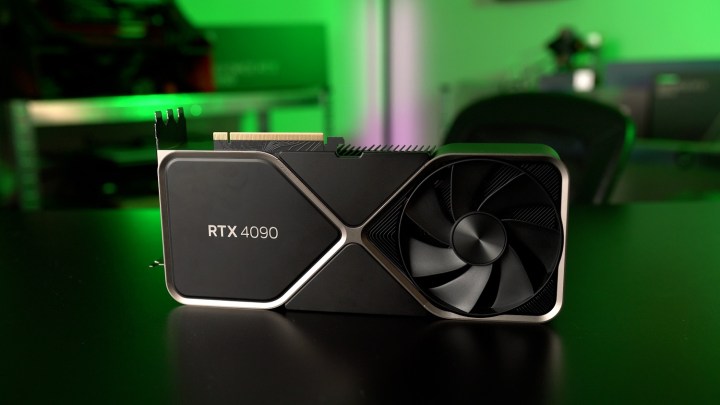
Nvidia GeForce RTX 4090
The best graphics card for video editing
Pros
- Huge leaps in 4K gaming performance
- Excellent ray tracing performance
- High power and thermals, but manageable
- DLSS 3 performance is off the charts
Cons
- Very expensive
- DLSS 3 image quality needs some work
Why should you buy this: It’s the most powerful graphics card you can buy today, hands down.
Who’s it for: High-end enthusiasts that want the best of the best regardless of price.
What we thought of the Nvidia GeForce RTX 4090:
The RTX 4090 is a nonsense graphics card, and we mean that in the best way possible. It’s $1,600, which is hard to justify spending on any graphics card. But if you want the best of the best, the RTX 4090 is it, and by a significant margin.
The previous GPU champion, the RTX 3090 Ti, looks puny by comparison. Based on our testing, the RTX 4090 is nearly 70% faster than the RTX 3090 Ti, and almost 90% faster than the RTX 3090. It’s a 4K graphics card that enables features like ray tracing in the most demanding games available today.
It’s overkill for most people, and it comes with some high demands. You’ll need a power supply with a lot of wattage, and you’ll need a case to accommodate the card’s massive size. It’s a reasonable trade-off for high-end enthusiasts, though, especially with features like DLSS 3 on offer.

Nvidia GeForce RTX 4090
The best graphics card for video editing

AMD Radeon RX 7900 XT
The best graphics card for VR
Pros
- DisplayPort 2.1 support
- Powerful 4K gaming
- Relatively small
Cons
- Disappointing generational improvements
- Loud and hot
Why should you buy this: It’s a powerful 4K GPU, and it supports DisplayPort 2.1 for high-end VR headsets.
Who’s it for: VR enthusiasts who want to drive high-end headsets.
What we thought of the AMD Radeon RX 7900 XT:
The AMD RX 7900 XT isn’t the best graphics card on the market, but it’s the best choice for VR. The main reason why is support for DisplayPort 2.1. High-end VR headsets require a ton of bandwidth, and DisplayPort 2.1 is the only connection standard that can deliver.
Although the RX 7900 XT doesn’t pose a great value, it’s no slouch of a GPU. Even at the high resolutions demanded by VR, it can deliver solid frame rates. It’s even faster than Nvidia’s RTX 4070 Ti, all while costing around the same price.
Even better, you can find it readily available at online retailers. Popular graphics cards still sell out immediately, but the RX 7900 XT is available at list price basically everywhere. It’s great for VR, but you can also leverage it for 4K gaming on a typical monitor.

AMD Radeon RX 7900 XT
The best graphics card for VR
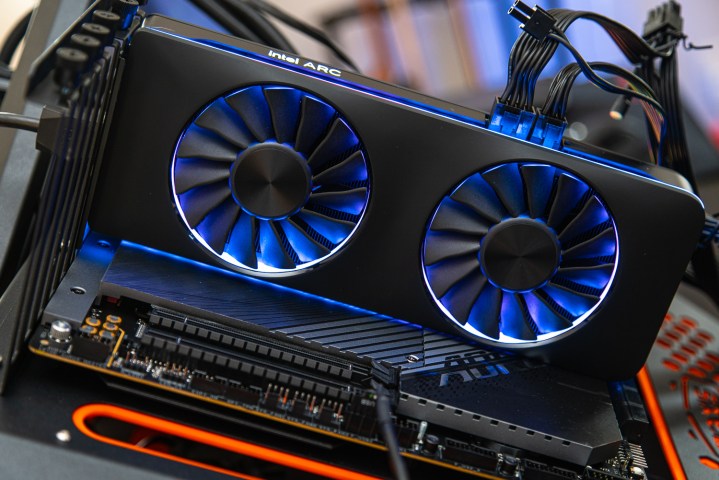
Intel Arc A750
The best graphics card for the money
Pros
- Great 1080p and 1440p gaming performance
- Competitive ray tracing performance
- Relatively inexpensive
Cons
- Resizable BAR is necessary
- XeSS needs some work
Why should you buy this: It’s a great graphics card for the price, minus a few bugs.
Who’s it for: Gamers looking for a great deal that don’t mind dealing with a few bugs.
What we thought of the Intel Arc A750:
Intel’s Arc A750 has gotten much better since launch, now sporting solid DirectX 9 support and much faster drivers. It has always been competitive with Nvidia’s RTX 3060 while costing around $100 less, but it looks even more enticing now that Intel has slashed the A750’s price to $250.
AMD usually is the budget alternative to Nvidia, and although that’s still true, Nvidia has been the way to go if you want to turn on ray tracing. The Arc A750 has competitive ray tracing, unlike its AMD counterparts, meaning it can truly go toe-to-toe with the RTX 3060.
On top of that, the card also supports Intel’s XeSS upscaling feature, which uses AI to upscale your games and improve performance. It’s not available in a ton of games, but Intel should add support in more titles over the coming months.

Intel Arc A750
The best graphics card for the money
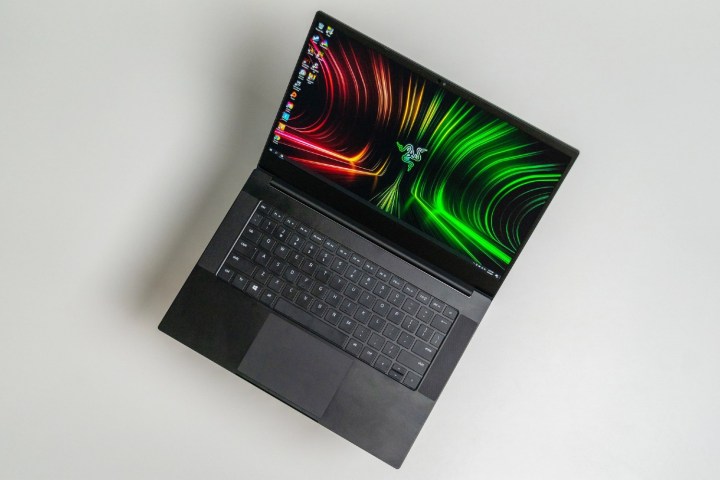
Nvidia GeForce RTX 3060 mobile
The best graphics card for laptops
Pros
- Available in a ton of laptops
- Adequate for 1080p gaming
- Huge improvement over previous gens
Cons
- Not ideal for hardcore gamers
Why should you buy this: It offers great performance without adding undue bulk to modern laptops.
Who’s it for: Power gamers on the move.
What we thought of the Nvidia GeForce RTX 3060 mobile:
Nvidia’s RTX 3060 is one of the latest iterations of its leaner mobile gaming solutions, but that doesn’t mean it lacks power. It offers a greater number of CUDA cores than previous generations of Nvidia graphics card mobile chips and delivers a sizable performance improvement over the past generation.
Although the GeForce RTX 3060 falls behind its full-scale desktop and mobile counterparts, its real strength lies in not outputting anywhere near the level of heat generated by big-scale GPUs. That means you’ll still find the RTX 3060 in laptops that are sleek and thin and don’t weigh too much. You can see the results in this older Razer Blade that we previously used in testing that weighs just 4.5 pounds and offers performance that in years gone by you’d only find in chunky gaming machines that weigh close to double that.
There are some solid alternatives in this space, with both AMD and Nvidia offering mobile options with greater and lesser performance depending on your needs. In our opinion, RTX 2070 Max-Q offers all the performance most users could want, all in a low-profile chipset. It’s a great solution for those who want optimal video performance from a smaller laptop. If you’re a gamer or just want some enhanced graphics on your small form-factor laptop, this is a great choice.

Nvidia GeForce RTX 3060 mobile
The best graphics card for laptops

Nvidia GeForce RTX 4070 Ti
The best graphics card with DLSS 3
Pros
- DLSS 3
- Excellent thermal performance
- Solid value at 1440p and 1080p
Cons
- Poor performance at 4K
- Will likely sell above list price
Why should you buy this: It’s the cheapest option of Nvidia’s current generation, and it supports DLSS 3
Who’s it for: Gamers who want flagship performance but don’t have an unlimited budget.
What we thought of the Nvidia GeForce RTX 4070 Ti:
The RTX 4070 Ti isn’t a perfect graphics card. It’s very expensive at $900, and it’s beaten by cheaper current and last-gen options from AMD. However, it still delivers high-end 4K gaming performance and comes with the key feature of Nvidia’s RTX 40-series graphics cards: DLSS 3.
DLSS 3 adds DLSS Frame Generation, allowing you to massively improve your frame rate in games like Atomic Heart, Cyberpunk 2077, and, Warhammer 40:000: Darktide. It’s exclusive to Nvidia’s most recent generation, and although DLSS 3 isn’t available in every game, it’s a selling point in the few demanding titles that feature the tech.
In standard performance, the RTX 4070 Ti delivers 4K gaming performance on the level of last-gen flagships, narrowly beating out cards like the RTX 3090. It’s still a very powerful GPU, even if it’s a bit expensive for the current generation. The good news is that prices are dropping, with some models available for around $850.

Nvidia GeForce RTX 4070 Ti
The best graphics card with DLSS 3
Frequently Asked Questions
How much should you spend on a graphics card?
As a rule of thumb, you should dedicate about 30% of your budget to a graphics card for a gaming PC. For 1080p, you should spend around $300 to $400; for 1440p, around $400 to $500; and for 4K, $600 or above. The Radeon RX 6600 XT targets 1080p at $379, the GeForce RTX 3070 is great for 1440p at $500, and the GeForce RTX 3080 is the perfect video card for 4K at $700.
Graphics cards are vastly overpriced in 2022, though. As it stands now, you can expect to pay double what you should for each resolution. Hopefully, that will change in the coming months.
How can you find the right power supply for a graphics card?
Nvidia and AMD recommend power supply wattage for their most recent graphics card. The Radeon RX 6800 XT, for example, draws 300W of power and AMD recommends a 750W PSU at least. Similarly, the GeForce RTX 3080 video card draws 320W and Nvidia recommends a 750W PSU. These recommendations aren’t always perfect, though, so we recommend using a PSU calculator.
How do you know which graphics card will best suit your needs?
Finding the graphics card that will best suit your needs comes down to the resolution of your display and the kinds of games you play. The Nvidia GeForce RTX 3080 is great for 4K, for example, but it’s overkill for 1080p where the AMD Radeon RX 6600 XT shines. The lower your display’s resolution, the less you need to spend on a graphics card.
Beyond that, consider the games you want to play and at what frame rates. You can use the Nvidia GeForce GTX 1660 Super for everything from Counter-Strike: Global Offensive to Borderlands 3, but you might need to step up to the GeForce RTX 3070 to play games like Assassin’s Creed Valhalla.
Editors’ Recommendations

